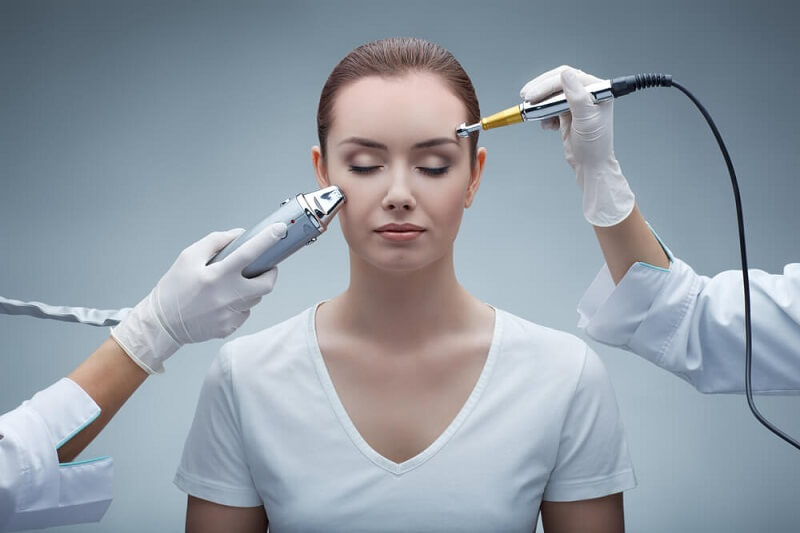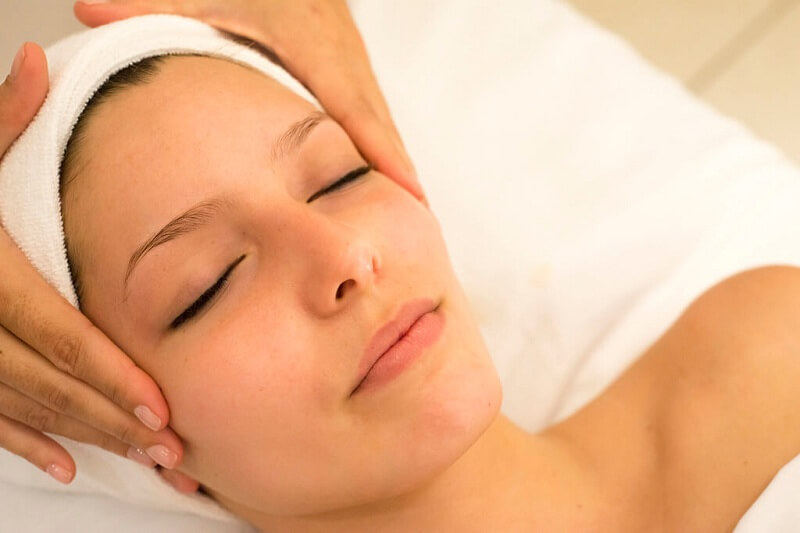There are 32 muscles in our face alone – and many more on our body. Specialists apply microcurrent facial treatments to engage or relax them and create a younger look. This treatment can fix wrinkles, scarring, hyperpigmentation, laxity, and other skin imperfections or conditions. And the best of all, it’s painless – in fact, patients falling asleep on the operating table is not uncommon.
Microcurrent facial toning causes reactions similar to a deep massage: It relaxes, tones, and softens the skin. Technology gives microcurrent therapy the perk of making the process much faster than traditional ways ever could. A series of additional medical specialties like degenerative affections, orthopedics, or surgery, also widely use microcurrent technology.

But before diving into its benefits, here are some general facts on microcurrents and how micro they really are:
About the Microcurrent Facial Technology
Microcurrent therapy is also known as Microcurrent Electrical Neuromuscular Stimulator – in short, MENS. The technology has been around since the ‘70s. It strived in cosmetic medicine and health branches due to its ability to apply faintly noticeable microampere currents, which mimic our own body’s natural electric currents.
Do not confuse it with microdermabrasion which uses microcrystals to remove dead cells. In comparison, microcurrent treatments employ direct electrical current to fix deeper problems of the skin. Specialists use the 0.1-680 Hz frequency pulsation of 300-500μA (micro Amps) in skin toning, soft wrinkles removal, and micro-lifting procedures. To put things in perspective, this amounts to millionths of an Ampere. In contrast, a residential power outlet can withstand a maximum of 15 – 20 Amperes.
Together with microdermabrasion and other facial treatments, microcurrent therapy is a non-surgical facelift used in skin rejuvenation. It’s popular as a non-intrusive, pain-free, and simple treatment that shows instantaneous results. For further reading on rejuvenation techniques, you can read our article about skin rejuvenation practices and outcomes.
MENS also is an electrotherapy procedure, together with:
- High-frequency alternating electrical currents, which are also used to treat skin conditions. Additionally, they promote healing and have antibacterial
- Faradic therapy, which uses direct, pulsed, or surged electrical currents to tone muscles.
- Galvanic treatment, which uses direct and constant electricity to clear, soften, and emulsify the skin.
What Can Microcurrent Therapy Treat?
Microcurrent facial treatments can tone, stimulate, and rejuvenate the skin overall. In addition, specialists also use it to treat the following visible skin imperfections and conditions:
- Sunburn skin damages;
- Acne marks and general scarring;
- Stretch marks;
- Cellulite;
- Oily or dry skin;
- Blackheads & whiteheads;
- Lax skin;
- Circulatory problems;
- Low eyebrows and lax, small skin areas;
- Lymphatic liquid retention;
- Light cases of hyperpigmentation – you can visit our articles on how to treat hyperpigmentation and reduce freckles for more on this subject;
- Coarse or dehydrated skin – for more treatments visit our article about extremely dry skin treatments;
- Signs of aging.

Microcurrent facial treatments encourage the production of collagen and elastin. These are 2 structural proteins that are fundamental for a firm, elastic skin. By sending waves of electrical micro-currents into face or body skin and tissues, the technology energizes facial muscles. Hospitals use MENS to enhance healing and treat pain, neuropathy caused by diabetes, macular degeneration, or ruptured tendons and ligaments.
How Microcurrent Facial Treatments Work
Toning skin with microcurrent treatments is similar to a full body workout: If done right, it engages every face muscle. This is possible because, unlike body muscles, the ones on our face are directly connected to our skin. Specifically, the microcurrents pass through muscles and activate the Golgi organ. This organ is responsible for identifying muscle tension changes.
The treatment removes long-stored toxins and waste, dead skin cells, and impurities, thus increasing cellular metabolism. It also re-educates the muscles, stretching or shortening them to optimize the skin’s look and get some years off a patient’s face. The therapist’s extensive knowledge on facial musculature is imperative for this process.
The therapist can regulate the depth of a microcurrent facial or body treatment by optimizing the current’s frequency:
- Micro-currents of 600 Hz and higher affect skin surface and can treat superficial imperfections.
- Frequencies around 500 Hz can reach our skin’s sub-surface and treat deeper scars, wrinkles, or spots.
- Micro-current treatments around 300 Hz can stimulate the area’s lymphatic system.
- Micro-currents around 20 Hz can improve circulation in our face or body.
- 10 Hz frequencies can reach facial muscles and the Golgi organs.
- 8 Hz micro-currents reach deeper areas of our face and body.
You can see improvements after the first treatment. However, many cases of rejuvenation or scarring need a series of sessions to reach the desired results.
Microcurrent Treatment Frequency
Microcurrent facial treatments last between 60 and 90 minutes. Frequency depends on each case, but here are some generalizations:
- Patients younger than 30 years old often only need microcurrent facial treatment to slow down aging. This can mean anything from 2 or 3 sessions per year to a maintenance session every 2 months.
- Specialists usually advice patients between 30 and 40 to start with a series of 6-10 sessions a week or a few days apart, then continue with maintenance treatments every 7 weeks.
- For patients between 40 and 50 years of age, therapists usually conduct 10 to 12 starting sessions. These are followed by maintenance microcurrent treatments as per a specialist’s recommendation.
- 50 to 60 years old patients can start with 15 sessions, one every 2 or 3 days.
- Patients over 60 years old will need up to 18 treatment sessions and another visit for maintenance every 4 weeks.

Microcurrent Facial Treatment Costs
Pricing for microcurrent sessions varies in terms of duration and clinic. On average, a one-hour session costs $100 or more and a 90-minutes session can reach $200. Some clinics can apply discounts for treatment packages paid upfront.
Risks & Adverse Reactions of Microcurrent Therapy
Before undergoing a microcurrent facial session, patients should always present or talk about their full medical history with their cosmetic medicine specialist. Microcurrent treatments are generally not recommended to patients:
- with heart issues;
- with a pacemaker should not use microcurrent treatment methods under any circumstances;
- who are pregnant women;
- afflicted with thrombosis;
- suffering phlebitis disease;
- has epilepsy;
- who are affected by any type of cancer.
Microcurrent therapy does not cause skin damage. However, given that microcurrent facial therapy engages the muscle tissue in our face to produce a quick detoxification effect, the cellular response is stronger. Adverse effects of microcurrent treatments are rare, but can manifest themselves through a general flu-like sentiment: Patients may notice nausea, fatigue, and drowsiness after 90 minutes or during the first 24 hours. Patients who suffer from certain conditions are more prone to side effects.
However, some patients have reported further skin issues after microcurrent treatments. These manifested themselves through redness, flakiness, itching, or a general sensation of discomfort. A probe into the matter has discovered these were caused by microorganisms on improperly cleaned tools. Hence, the importance of having the skin properly cleaned before starting the process and cleaning equipment before and after every use.
Microcurrent Therapy Before & After Care
Some clinics might advise drinking 30 or more ounces of water starting 2 hours before treatment since this appears to reduce some of the side effects.

Although no extra preparation is required for a microcurrent facial treatment, specialists have observed that patients with a healthy diet show the best results. This includes fresh fruits and vegetables, plenty of fibers, and vitamins. Experts also advise drinking water for an overall healthy skin. Patients can apply cosmetic and homemade skin rejuvenation treatments to enhance the effects of this therapy. No recovery time needed after treatment, but specialists might recommend permanent care solutions for a healthier skin.
Microcurrent Facial FAQs
Please keep in mind these are generalized facts. Specific situations have distinct implications which you may need to discuss with a dermatologist. Here are some common questions (and their answers) about microcurrent therapy.
Are microcurrent treatments painful?
No. You could barely call the sub-sensory sensation of microcurrent therapy a discomfort – in fact, many patients consider it relaxing.
Can I use home cosmetic treatments or procedures at the same time?
Microcurrent treatments usually complement and enhance the results of cosmetic procedures. However, patients should always check with their doctor if the alternative treatment is incompatible with the microcurrent technique.
Will a microcurrent facelift cause redness or burning to my skin?
No, microcurrent facial and body treatments do not cause any type of skin damage. Redness is highly unlikely, but third-party agents like bacteria or fungi can cause it.
Can I wear make-up after a microcurrent session?
Specialists generally advise patients to wait for a few hours until applying foundation to allow the skin to breathe for a bit. There are no restrictions on the cosmetic products patients can use after such a treatment.
Microcurrent facial therapy is a viable skin rejuvenation method. The realm of cosmetics is widely using it to solve many types of skin problems or early aging signs, but not without restrictions. Patients should talk to a dermatologist about their full medical history. This will decide whether they should use microcurrent therapy, and which supplementary cosmetic treatments might enhance the process. After all, many say laughter is the best way to engage all our facial muscles – so we might as well give it a try first.
